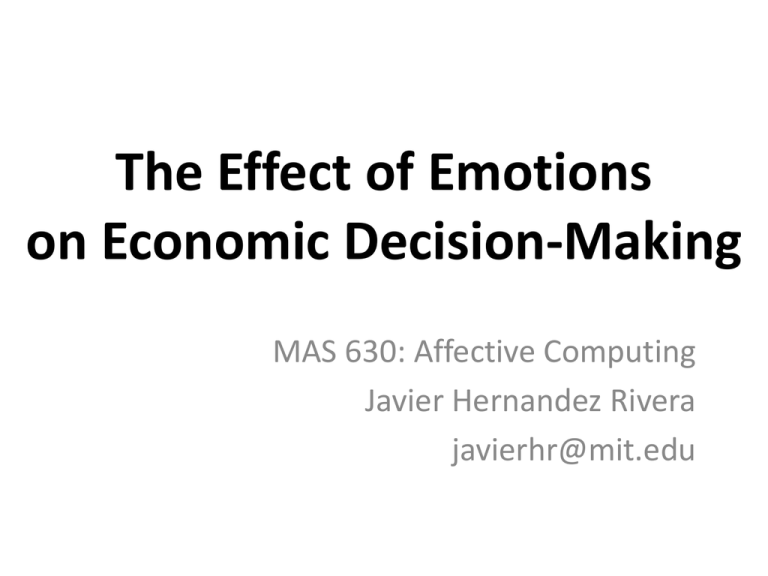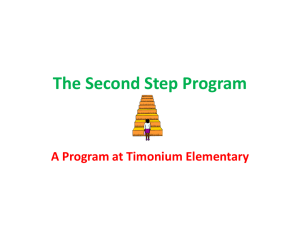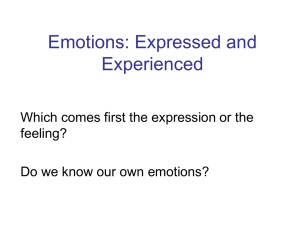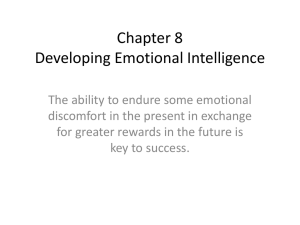The Effect of Emotions on Economic Decision-Making
advertisement

The Effect of Emotions on Economic Decision-Making MAS 630: Affective Computing Javier Hernandez Rivera javierhr@mit.edu Contents • • • • • • Motivation & Project Goals Background Experimental Setting Data Synchronization & Visualization Preliminary Data Analysis Conclusions 2 Motivation & Project Goals 3 Affect in Decision Making Emotions have been long neglected in decision making (DM) in favor of a deliberative and reason-based decision making (Shafir, Simonson, & Tversky, 1993) Why? Affect can lead us to irrational decision making (ignoring the odds or negative consequences) Playing the lottery Smoking Flying by plane Happy Makes People Feel Relaxed Fearful 4 Project Goals What? • Validate current economic DM theories (e.g.,Somatic Marker Hypothesis) in different settings • Understand how negative emotions (fear and anger) affect the DM process How? • Emotion elicitation • Two-armed Bandit task • Electrodermal activity (EDA) Why? • Understand the role of emotions in DM • Explore the benefits and limitations of most common emotional responses to catastrophes 5 Background 6 Roles of Emotions in Decision Making 1) Minimize negative emotions vs 2) Emotions as common currency 3) Encode and recall information Positive Negative 4) Motivator of information processing and behavior (Peters E., Vastfjall D., Garling T. & Slovic P, 2006) 7 Factors that Influence Decision Making Perceived value Time1 Uncertainty2,3 Risk3,4 time Visceral States Sexual Ownership Arousal5 Relaxed7 Hunger6 1 (Lowenstein, 1992) 4(MacGregor 7(Pham, Disgusted8 Sad8 2(Bar-Anan., Wilson & Gilbert , 2009) et al., 2005) 5(Ariely & Loewenstein, 2006) Hung, Gorn, 2011) 8(Lerner, 3(Lerner, 6(Read Small & Loewenstein, 2004) & Tiedens, 2006) & Leeuwen, 1998) 8 Decision Making and Physiology Somatic Marker Hypothesis (SMH) Theory: Physiological responses (a.k.a. somatic markers), learned in daily life activity, consciously or unconsciously influence the decision-making process. (Bechara A., Damasio H., & Tranel D. 1991, 1997) Experiment: Iowa Gambling task A B C D Disadvantageous decks Lead to overall loss Advantageous decks Lead to overall gain Risky option (high variance) Safe option (low variance) x 100 Trials Observation: Higher EDA responses before choosing risky and disadvantageous options, even before people could consciously identify the risky decks. 9 Anger and Fear Most common emotional reactions after catastrophic events such as the terrorist attacks of 9/11 or the economical crisis Anger Fear Appraisal to negative events1 Certainty Control Uncertainty Uncontrolled Influence on Decision Making1 Risk-seeking Optimistic assessments Risk-averse Pessimistic assessments Low High Physiologycal Responses2 1(Lerner and Keltner, 2000,2001) 2(Lerner, Dahl, Hariri & Taylor, 2006) 10 Experimental Setting Designed & conducted by Hyungil Ahn (Ahn, 2010) 11 Experimental Setting Neutral Fear x 25 Trials x 25 Trials Bet Money Option 1 Option 2 Bet Money Option 1 Option 2 Gain Loss - + Safe option (low variance) is better Anger Emotions Domain 1 Ownership - + Risky option (high variance) is better Domain 2 Risk + Uncertainty Experimental Setting: 1 Trial 1 1 2 3 4 5 6 EDA 3 2 Time 4 5 6 13 Data Synchronization & Visualization 14 Data Synchronization Surveys Loss-pass filter (0.16 Hz cutoff frequency) 15 participants were excluded because of corrupted signals (artifacts, low response) 20 participants were excluded because of missing information Number of Participants Frames EDA (20 Hz) Normalization Scale each subject between 0 and 1 Best Option Filtering Neutral Anger Fear Gain 3 3 5 Loss 4 5 5 Neutral Anger Fear Safe 7 8 10 Risky 7 8 10 25 x participants 2 = 1250 sessions trials Task Activity 15 Data Visualization (Neutral) Video (B B) . (N1 N1) (N2 Risky Option is Better Video N2) . . . . 1 1 1 2 (N1 (N N1) 2 1 2 2 2 . 1 2 12 1 1 1 . . . . . . . B) . . 2 1 1 2 11 1 . . . . . . . . . . . (N1 N1) 121 2 1 1 2 . 1 2 11 . . . . . . . . . . . . . . . . . . . . . 2 . . 2 2 111 (N3 N3) 2 211 1 1 1 1 11 1 . . . 1111 . . . . . . . . . 11 1 1 1 1 1 1 11 1 1 1 1 112 11 . . . . . . . . . . . . . . . . . . . . . . . . S) Gain Frame (3 participants) 11 11 1 1 . . .. . .. . . .. 2 . . . 1 . . N2)1 (N2 Selected Options S) (‘1’ is always the optimal selection) (N3 N3) 1 2 2 11 1 1 2 1 1 2 1 1 21 11 1 1 1 1 1 1 1 1 . . . . Safe Option is Better 2 22 2 . . . . . . . . 2 1 . . . 2 222 222 2 . .. . . .. . (N2 N2) (N3 N3) S) 2 2 2 . 21 2 1 21 1 1 1 211 11 11 111 1 2 1 111 . .. .. . . . . Data in . . . . . . . .. .. . . . . . . . 1 1 111 (N1 (N N1) (N2 N2) (N3 N3) . 1 1 1 11111 2 1111 1 1 1 1 1 2 1 1 . . 1 1 1 1 1 1 111 . 1 . . 211 . . . . .. . . . 111 1112111 .. . . . 1 . . . . . . . ... . . . S) .. . .. . . .. .. . . . . . . Neutral 2 (B B) 2 (N1 (N N1) (N2 1 2 1 21 (N3 N3) .1 N2) . . . 2 2 2 . . 2 . 2 2 2 12 22 2 1 11 1 2 1 1 . .1 2 .1 . . . 2 . .. . . . . . . 1. . . . . . .. . (N1 (N N1) . . 1 . (N1 (N N1) 1 122 21 1 . . .. (N2 2 2 2 . . . (N2 S) .. . . N2) (N3 N3) 2 2 1 1 11 1 11 1 2 2 2 2 1 1 2 21 1 21 2 1 21 2 12111 111 . . . . . . . .. . . . . . . . N2) 1 2 2 2 22222121221122 12221 . .. . . . . . . . . . . . . . . . . . . . .. . . . . .. 7 participants (350 trials) . .. 1 2 1 .2 12 1 . 12 21 12 12 1 . .2 1 . .. . . 2 1 . . . . .. . . . (N3 N3) 111211121111211 1 1 2 1 1 . . . . . . . . . .. . . . . . . . . . 1 1 11 1 1 2 22 . . . . .. . . . . . . . .. . . . . . S) Loss Frame (4 participants) S) 16 Data Visualization (Anger) Video (A1 Risky Option is Better Safe Option Video is Better A1) (A2 2 12 221 .. .. . A2) (A3 . . .... (A1 . . . .. . (A1 12212 . . (A1 . . . . . 2 1 211 1 2 1212 . . A3) S) Data in 2122112221221222222 ... . .. . . .. .. . . . . ... .. . . A2) (A3 2 1 1 1 2 1 2 1 1 2 2 1 2 2 1 2 2 1 1 1 2212 1 . . . . . . . . . . . . . . . . (A2 . . A3) 1 2 1 2 112 111211 2 1211 12112 11 . . . . . . . . . . . . . . . . . . . . . . . . . . . ... .. A2) (A3 A3) Anger . 12 (B B) . . . 2 1 . . . (A3 A1) . . S) . .. .. . . . . . . . A2) 11121 1 1 . . . . 111111 . . . .. . .. . . . .. .. .. . 1 2 . . . .. . . . . . . . . (A2 (A1 A3) 1 2 111 11211121 12111121112 1 . . .. . . . . A1) (B B) (A3 (A2 1. . . (B B) A2) A1) 12 2 2 12 Gain Frame (3 participants) . 221 2 112112 1 . . . .. . . .. . . . B B) . . . . . . . .. . . . (A2 . . .. . A1) 11 2 1 112 2 2 . S) 221221 12 122 122 21 2 122 2 21 2 1 .. . 221212121221 211212 1 . . . . . . .. . . . . . . . .. . . . (B B) A3) . . (A1 1 12 1 1 1 . 2 . . 2 . A1) . 1 . (A1 A1) (A2 (A1 . . . . . . . . A1) (A2 1 . . . . . .. . . . . . . . . .. . 11 . . 11 11 .. 12 2 1 . . . . . 1 . . . 1 2 2 11 2 1 2 1 12 11 1 21 1 1 22 1 1 1 1 1 2 2 1 12 1 . . . . . . . 1 11111 21 1121 1111 1 11 . . . . . .. ... .. . 1 21 11 . . . . (A2 . (A3 111 1111 . . . . .. . .. . . . ... . . . . . . . 111111 1 21 . . . . . . A2) 2 2 . 222222 . . . 11 2 2 111 1 .. . .. . . . . . . . . . . 1 11111 11111111 . . .. . .. . . . . .. . . .. 2 1 2 2 2 21 121 11 1 11 1 1 1 A2) 2 1 1 2 1 1 2 2 11 211 12 1 121121211 . . . . .. .. A3) (A3 . . A3) 8 participants (400 trials) .. Loss Frame (5 participants) S) 11 11 . . . . . . ... .. .. .. . . . . . . . . . A2) 2 . 11 111 . . . .. 1 1 . . 1 1 11 1 21 1 11 2 11 . . . .. . . . .. . 1 1 11 . . . . . . (A3 A3) S) 17 Data Visualization (Fear) Video (F1 F1) Safe Option is Better Video (F2 F2) 2 2 (F3 1 11 1 1 1 11. . . . . . . . (F1 F1) 21 1 . 2 1 11 . . . (F1 12 21 2 (F2 1 1 . . 2 1 . . . . 11 . 1 1 . . . . . 11 111 . F1) (F2 . . .. .. . . . .. F3) . 222 2 . F3) (F3 F3) S) . . . . . . . . . . . . . .. . . . . . . . . . . F1) 1 11122122 21222 . . . . . . . . (F2 F2) 21 1 1 . . . . . .. .. . F1) (F2 1111111111 1 11 111 .. .. . .. . 1 2 2 2 2 21 2 2 . . . .... . . . . F1)1 2 22 1 1 2 2 21 12221 2 212 1 12221 . . . . . . . . . . . . . . . . . . . . . . . . . (F1 . . . . . (F2 (F1 F1) . ..... . ... .. B) (F1 .... .. 2 22 2 2 2 222 . . .. . .. . .. . . .. . ... F3) S) Fear (F3 F3) . . . . . 10 participants (500 trials) S) . . . . . . . . . . .. . . . . . .. (F3 F3) S) Loss Frame (5 participants) 1 21222 21221212222 22221122 . . . .. . . . . . . .. .. . . . . . . ... . . . . . .. . . . . . .. . . . . (F2 2 1212 1 21 . 2112212211 . . . 1212212 .. . . (F3 222 2 S) 21 F2) 21 1 2 1 12 2 1 1 11 1111112111111 (F1 1 1 2 2 22 2 . . . . . . F3) 1 22 112 221211 1 111111 11 1 1 11 . . . . .. . (F2 . . . . . 2 211 F3) .. . (F3 F2) 12 21 111 11 12 1121 11 1 F1) . . . . 12 (F3 1 12 1 1 1 2111 1121 2. . . . . 1 . . 2 . .. . ... 1 . . 1 .. . Gain Frame (5 participants) 111111 1 . . .. . . .. . . 1 1111 . . .. . . . . . .. . . . . (F2 . . . . . . . . . . . .. . . . . . .. Data in F2) 2 . F2) 22111111111 F1) 12 11 1 1 1 S) 1 12 .. 2 21112122 . . . . . . (F1 S) . . . 1111111111 1111111111 .. .. . . .. .. .. . .. . . .. .. . . . . (F1 (F1 . .. . 111 1122211 1111111111 111 11 . . . . . . . . . ... . . . .. . . . .. . . . B) 1 .1 1 1 1 11 2 11 . 11121 1 2 1 . . 12 1 11 1 2. . . . .... . . . . .. (F3 F2) 2 1 2112122211111 2111221111 1 1 1 111 11111 2 1 2 . . 1 . . F2) .. .. . . . . Risky Option is Better F2) (F3 F3) S) 111212121 2112121212121121 . .. . . F1) 1222111111111111111 111111 . . . . . . . . . . . . .. . . . . . . . . . . . ... . . .. . ... .. ... .. .. (F2 F2) (F3 F3) S) 18 11121111111111111111 11112 .. . . . . . . . . . . . . . . . .. . . . . . . Preliminary Data Analysis 19 Behavioral Responses: Speed Standard Error of the Mean (SEM) 25 Trial 2 3 4 EDA Time 5 6 20 Average Trial Response Time (sec) 1 15 10 5 0 0.5 Betting Surveys 1 Neutral (N = 350) 1.5 * 2 Anger (N = 399) 2.5 * 3 3.5 Fear (N = 500) People answer significantly faster in the negative emotional states, and fearful people are significantly faster than angry people. * Statistically Significant (Two Sample T-Test) 20 Behavioral Responses: Performance Advantageous Disadvantageous Emotions - Median Anticipatory Signal 0.8 Overall, people in the three emotional conditions perform similarly. 0.7 0.6 Safe Option Is Better % Risky 0.5 0.4 % of Selections 0.3 0.2 Risky Option is Better 0.8 0.5 0.1 0 0.8 Neutral Emotions - Median Anticipatory Signal Anger * Fear * 0.7 % Risky % Risky 0.6 Domains - Median Anticipatory Signal 0.7 0.4 Negative states are slightly better when the safe option is the optimal one, but they are slightly worse when the risky option is the optimal one. Fearful people tend to perform slightly better than angry people 0.6 0.3 0.5 0.2 0.4 0.1 0.3 0 0.2 0.1 * Neutral Neutral * Anger Anger Advantageous 21 Fear* * Statistically Significant (Two Sample T-Test) Fear Behavioral Responses: Risk Preference Non-Risky Option Risky Option Emotions - Median Anticipatory Signal 0.8 Although people in the neutral state significantly choose riskier options, people in the negative states prefer non-riskier options. 0.7 0.6 0.5 % Risky Gain Frame 0.4 0.3 % of Selections 0.2 0.1 0 Neutral 0.8 % Risky Emotions - Median Anticipatory Signal Anger Fear Domains - Median Anticipatory Signal In the loss frame, people prefer the riskier options. The difference is significant for the neutral and fear settings. 0.5 0.7 0.4 0.6 0.3 0.5 % Risky * 0.7 0.6 0.8 Loss Frame * 0.2 0.4 0.1 0.3 0 0.2 0.1 0 * Neutral Neutral Anger Anger Non-Risky Risky * Fear * Statistically Significant (Two Sample T-Test) 22 Fear Behavioral Responses: Pleasantness 100 90 90 80 80 Pessimistic vs Optimistic 100 70 60 50 40 30 Angry people in the loss frame perform slightly better than angry people in the gain frame. 70 60 50 40 30 20 20 10 10 0 100 Average of Pleasantness the Outcomes Ratings on Pessimistic vs Optimistic Loss Frame 0 N A F N 90 80 80 70 60 50 40 30 60 50 40 30 20 10 10 0 Neutral N Anger A Fear F F 70 20 0 A 100 90 Pessimistic vs Optimistic Average of the % of Selections Advantageous Pessimistic vs Optimistic Gain Frame N A Neutral Anger F Fear As expected, the overall pleasantness ratings on the outcomes are slightly lower in the loss frame. Moreover, angry people are surprisingly unpleased even though they obtained slightly higher outcomes. Preprocessing for EDA Analysis Baseline Removal Smoothed Minimum Sliding Window over 10 minutes Filtering Loss-pass filter EDA (0.16 Hz cutoff frequency) Normalization Scale each subject between 0 and 1* Feature Extraction Normalized Area under the Curve 0.2 0.1 0.2 µS 0 0.1 0 0.3 5 10 15 20 25 30 35 40 5 10 15 20 25 30 35 40 5 10 15 20 25 30 35 40 Original Signal Low-pass filtered signal Baseline Corrected signal 0.2 0.3 0.1 0.2 0 0.1 Minutes *(Lykken, D.T., Venables, P.H, 1971) 24 Anticipatory Responses: SMH Iowa Gambling Task Two-Armed Bandit Task -4 2 ACTIV ACTIV ACTIV ACTIV 2 1 0 0 1-8 9-17 Trials N 9-17 Trials 0 18-25 9 1-8 9-17 Trials 1-8 9-17 Trials 18-25 N 18-25 7 6 N 95 84 3 7 2 6 1 4 Risky Option is Better 8 Total # of Options Total # of Options Total # of Options Hunch Conceptual Period N (n: 625) 1 18-25 7 PrePrePunishment Hunch N (n: 625) -4 2 0 1-8 8 50 -4 1 1 1-8 1-8 9-17 Trials 9-17 18-25 18-25 3 Total # of Options Average Activation Safe Option Is Better 2 9 Total # Selections x 10 N (n: 625) x 10 Safe Option Is Better x 10 N (n: 625) x 10-4 6 N 9 5 4 8 3 7 2 6 1 5 0 *Trials 4 1-8 1-8 * 9-17 9-17 Trials * 18-25 18-25 * 3 The SMH hypothesis (higher EDA responses before disadvantageous Advantageous selections) seems plausible when the Safe Option is optimal and it Disadvantageous * Statistically Significant might be delayed when the Risky Option is the optimal one. 2 2 1 1 0 1-8 9-17 Trials 18-25 0 1-8 9-17 Trials 18-25 Main Limitations of the Analysis 1) Reduced number of participants (35 part. were excluded) 2) Consecutive tasks distort EDA responses InitTrial SelectOption (0.00 sec) (1.65 sec) 1 2 3 AnswerExperience (6.28 sec) 4 5 Too short to display anticipatory responses? AnswerPrediction (5.66 sec) 6 Cognitive load of the first survey? Average EDA response (N: 1250 trials) BetClick GetOutcome (1.86 sec) (0.64 sec) Betting ~4 sec. AnswerConfidence (4.15 sec) Answering Surveys ~16 sec. 26 Conclusions • People in the negative states bet faster than people in the neutral state. • Fearful people bet faster and performed slightly better than angry people. • Although most of the people preferred riskier options, angry and fearful people in the gain frame preferred safer options. • Angry people performed slightly better in the loss frame. • Angry people were less pleased in the loss frame even though they obtained relatively higher outcomes. • Although the SMH seemed plausible in the Two-armed Bandit Task, further analysis is required. Time Distribution Deliverables Data Analysis Readings Data Synchronization 27 References I Ahn, H.I. (2010). Modeling and Analysis of Affective Influences on Human Experience, Prediction, Decision Making, and Behavior. MIT PhD Thesis. Ariely D., & Loewenstein G. (2006). The Heat of the Moment: The Effect of Sexual Arousal on Sexual Decision Making. J. Behav. Dec. Making, (19), 87-98 Bar-Anan Y., Wilson T & Gilbert (2009) . The Feeling of Uncertainty Intensities Affective Reactions. Emotion 9, (1), 123-127 Bechara A., Damasio H., & Tranel D. (1997). Deciding Advantageously Before Knowing the Advantageous Strategy. Science. Damasio, A. R., Tranel, D., & Damasio, H. (1991). Somatic Markers and the Guidance of Behavior: Theory and Preliminary Testing. Lerner, J. S., Dahl, R. E., Hariri, A. R., & Taylor, S. E. (2007). Facial Expressions of Emotion Reveal Neuroendocrine and Cardiovascular Stress Responses. Biol Psychiatry; 61:,253-260 Lerner, J. S., & Keltner, D. (2000). Beyond Valence: Toward a Model of Emotion-specific Influences on Judgment and Choice. Cognition and Emotion, 14(4), 473–493. Lerner, J. S., & Keltner, D. (2001). Fear, Anger, and Risk. Journal of Personality and Social Psychology, 81(1), 146–159. Lerner, J. S., Small, D. A., & Loewenstein, G. (2004). Heart Strings and Purse Strings: Effects of Emotions on Economic Transactions. Psychological Science, 15, 337–341. 28 References II Loewenstein, G. & Prelec, D. (1992). Anomalies in Intertemporal Choice: Evidence and an Interpretation. Quarterly Journal of Economics. 573-597 Lykken, D.T. & Venables, P.H.(1971) Direct Measurement of Skin Conductance: A Proposal for Standarization. Psychophysiology 8(5), 656–672 MacGregor, Slovic P, Peters P & Finucane M. (2005) Affect, Risk, and Decision Making. Health Psycholoy, 24 (4) S35-S40 Peters E., Vastfjall D., Garling T. & Slovic P. (2006). Affect and Decision Making: A “Hot” Topic. Journal of Behavioral Decision Making, 19, 79-85 Pham M., Hung I. & Gorn G. (2011). Relaxation Increases Monetary Valuations. Journal of Marketing Research, 48 Read & Lweeuwen (1999). Predicting Hunger: The Effects of Appetite and Delay on Choice. Organizational Behavior and Human Decision Processes, 76(2), 189-205 Shafir, E., Simonson, I., & Tversky, A. (1993). Reason-based Choice. Cognition, 49, 11-36. 29







